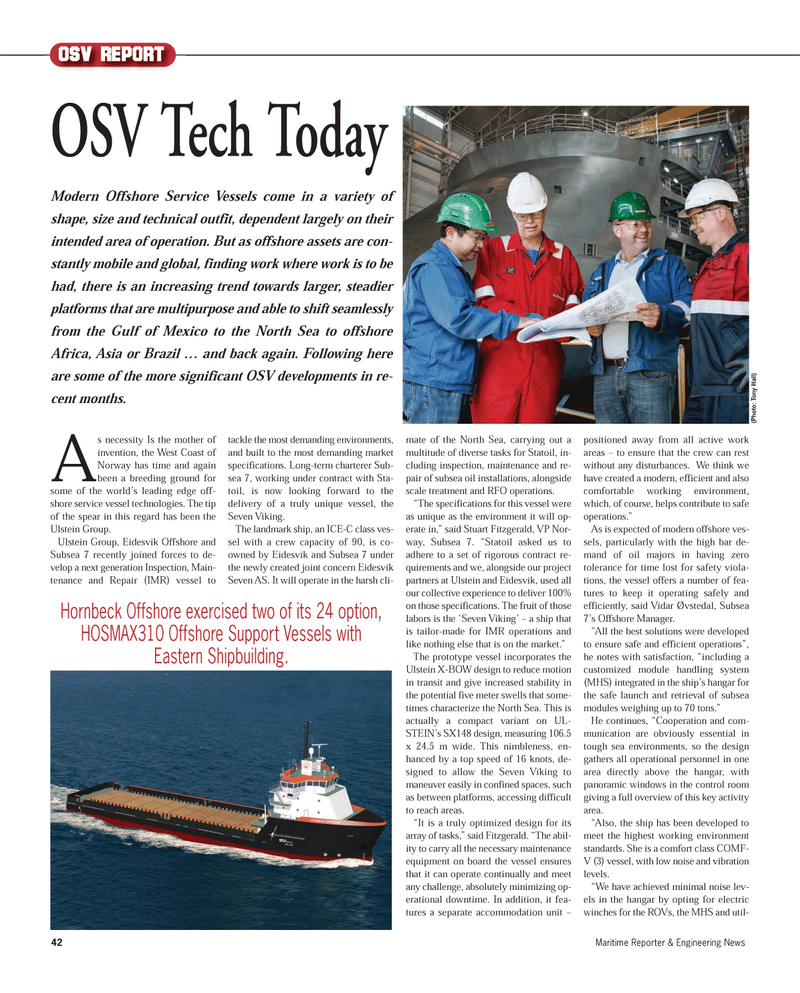
Page 42: of Maritime Reporter Magazine (November 2012)
Workboat Annual
Read this page in Pdf, Flash or Html5 edition of November 2012 Maritime Reporter Magazine
42Maritime Reporter & Engineering News OSV reportAs necessity Is the mother ofinvention, the West Coast of Norway has time and again been a breeding ground forsome of the world?s leading edge off- shore service vessel technologies. The tip of the spear in this regard has been the Ulstein Group.Ulstein Group, Eidesvik Offshore and Subsea 7 recently joined forces to de-velop a next generation Inspection, Main- tenance and Repair (IMR) vessel to tackle the most demanding environments, and built to the most demanding market specifications. Long-term charterer Sub- sea 7, working under contract with Sta- toil, is now looking forward to the delivery of a truly unique vessel, the Seven Viking. The landmark ship, an ICE-C class ves- sel with a crew capacity of 90, is co- owned by Eidesvik and Subsea 7 under the newly created joint concern Eidesvik Seven AS. It will operate in the harsh cli- mate of the North Sea, carrying out amultitude of diverse tasks for Statoil, in- cluding inspection, maintenance and re-pair of subsea oil installations, alongsidescale treatment and RFO operations. ?The specifications for this vessel were as unique as the environment it will op- erate in,? said Stuart Fitzgerald, VP Nor- way, Subsea 7. ?Statoil asked us to adhere to a set of rigorous contract re-quirements and we, alongside our projectpartners at Ulstein and Eidesvik, used allour collective experience to deliver 100% on those specifications. The fruit of those labors is the ?Seven Viking? ? a ship that is tailor-made for IMR operations and like nothing else that is on the market.? The prototype vessel incorporates the Ulstein X-BOW design to reduce motion in transit and give increased stability in the potential five meter swells that some- times characterize the North Sea. This is actually a compact variant on UL- STEIN?s SX148 design, measuring 106.5 x 24.5 m wide. This nimbleness, en- hanced by a top speed of 16 knots, de-signed to allow the Seven Viking to maneuver easily in confined spaces, such as between platforms, accessing difficult to reach areas. ?It is a truly optimized design for itsarray of tasks,? said Fitzgerald. ?The abil- ity to carry all the necessary maintenanceequipment on board the vessel ensures that it can operate continually and meetany challenge, absolutely minimizing op- erational downtime. In addition, it fea- tures a separate accommodation unit ?positioned away from all active work areas ? to ensure that the crew can rest without any disturbances. We think we have created a modern, efficient and also comfortable working environment, which, of course, helps contribute to safe operations.? As is expected of modern offshore ves- sels, particularly with the high bar de-mand of oil majors in having zero tolerance for time lost for safety viola-tions, the vessel offers a number of fea- tures to keep it operating safely and efficiently, said Vidar Øvstedal, Subsea 7?s Offshore Manager. ?All the best solutions were developed to ensure safe and efficient operations?, he notes with satisfaction, ?including a customized module handling system(MHS) integrated in the ship?s hangar for the safe launch and retrieval of subsea modules weighing up to 70 tons.? He continues, ?Cooperation and com-munication are obviously essential in tough sea environments, so the design gathers all operational personnel in one area directly above the hangar, with panoramic windows in the control room giving a full overview of this key activity area. ?Also, the ship has been developed to meet the highest working environment standards. She is a comfort class COMF-V (3) vessel, with low noise and vibration levels. ?We have achieved minimal noise lev- els in the hangar by opting for electric winches for the ROVs, the MHS and util- OSV Tech Today Modern Offshore Service Vessels come in a variety of shape, size and technical outfit, dependent largely on their intended area of operation. But as offshore assets are con- stantly mobile and global, finding work where work is to be had, there is an increasing trend towards larger, steadier platforms that are multipurpose and able to shift seamlessly from the Gulf of Mexico to the North Sea to offshore Africa, Asia or Brazil ? and back again. Following here are some of the more significant OSV developments in re- cent months.(Photo: Tony Hall) Hornbeck Offshore exercised two of its 24 option, HOSMAX310 Offshore Support Vessels with Eastern Shipbuilding. MR#11 (42-49):MR Template 11/6/2012 3:03 PM Page 42

 41
41

 43
43
